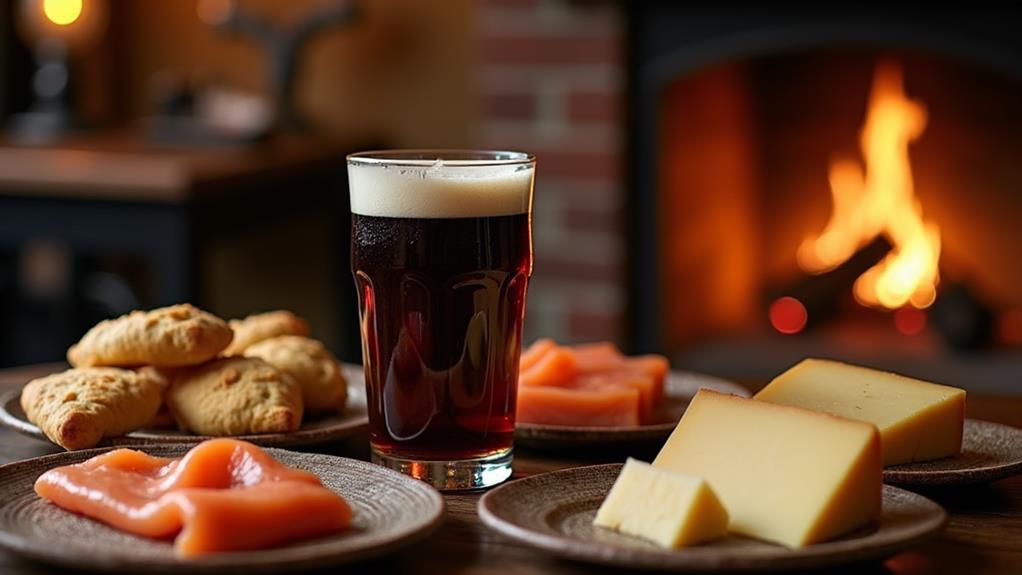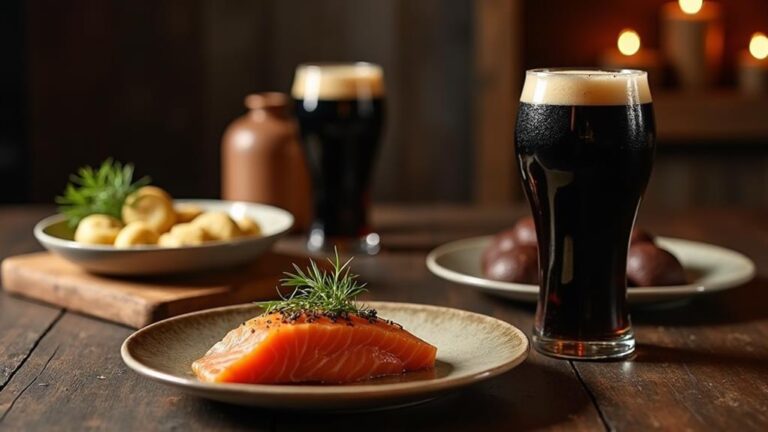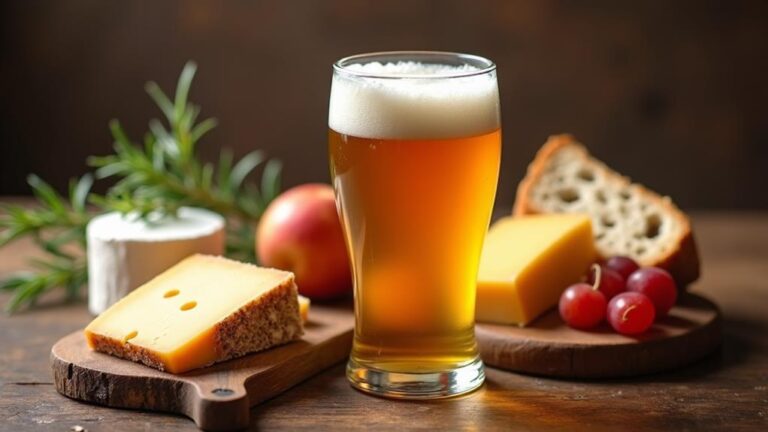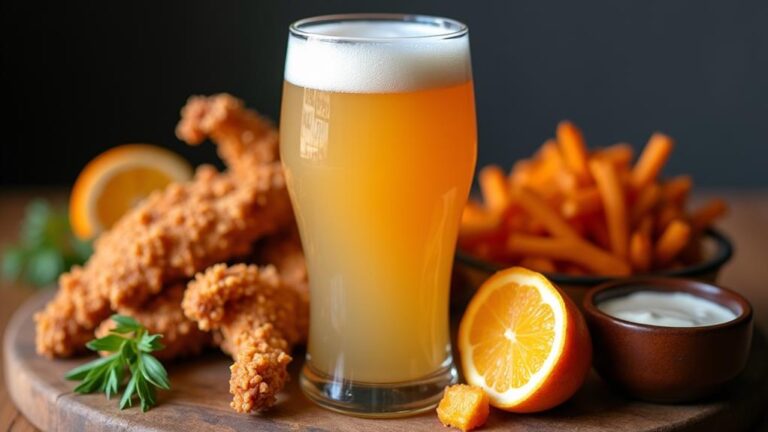Perfect Scotch Ale Food Pairings
When pairing food with Scotch Ales, you'll want to focus on rich, malty flavors that complement roasted game meats like pheasant and quail, as well as caramelized notes that align with dark chocolate and caramel desserts. Smoky flavors contrast beautifully with buttery cheeses like Brie and Gouda, while roasted root vegetables enhance the natural sweetness of both food and beer. Hearty stews and braised meats also pair well with malt-forward profiles. By understanding Scotch Ale characteristics and ideal food pairing principles, you'll be able to craft a harmonious and complex culinary experience that will leave you wanting to explore more.
Key Takeaways
- Pair Scotch Ale with roasted game meats like pheasant and quail to enhance sweetness and richness.
- Complement smoky flavors in Scotch Ale with buttery cheeses like Brie and Gouda for a delightful contrast.
- Match caramelized notes in Scotch Ale with dark chocolate and caramel desserts for a harmonious finish.
- Combine Scotch Ale with roasted root vegetables to enhance natural sweetness and malt characteristics.
- Balance the malt-forward profile of Scotch Ale with hearty stews and braised meats for a satisfying pairing.
Understanding Scotch Ale Characteristics
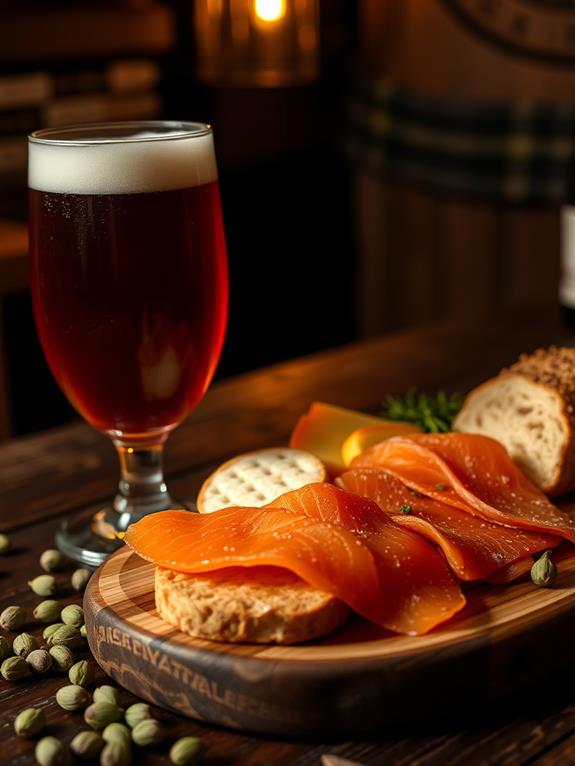
When you crack open a Scotch Ale, often referred to as "Wee Heavy," you're in for a treat. These rich, complex beers boast a robust flavor profile that's sure to delight. With an ABV exceeding 7%, Scotch Ales are sweet and sophisticated, featuring a rich malt-forward profile that's simply divine.
The intricate balance of sweetness and alcohol can create a delightful pairing experience that enhances both the beer and the food.
Visually, Scotch Ales range from light copper to dark brown, often with ruby highlights, and are topped with a large tan head that adds to their appeal. The aroma is deeply malty, with caramel notes and potential hints of peat or smoke, creating a distinctive scent.
Flavor-wise, Scotch Ales offer a rich maltiness achieved through kettle caramelization, with low to medium-low hop bitterness that allows the malt characteristics to shine.
When considering food pairings, it's crucial to understand these characteristics. The caramel notes in Scotch Ales make them an excellent match for dark chocolate, while their rich maltiness pairs perfectly with robust flavors.
Ideal Food Pairing Principles

You're now well-versed in the characteristics of Scotch Ales, and it's time to put that knowledge into practice. When it comes to ideal food pairings for Scotch ales, the focus is on rich, malty flavors that complement dishes like roasted game meats, enhancing the beer's sweetness and complexity.
The caramelized notes in Scotch ales make them suitable companions for desserts featuring dark chocolate or caramel, creating a harmonious balance of flavors. Additionally, consider how stout and savory pairings can inspire your Scotch ale selections, inviting a broader range of taste experiences.
To create perfect pairings, consider the smoky flavors in Scotch ales, which are beautifully contrasted by buttery cheeses like Brie and Gouda, highlighting both the creaminess of the cheese and the beer's richness.
Pairing Scotch ales with roasted root vegetables can enhance the natural sweetness of both the dish and the beer, creating a comforting dining experience. Hearty stews and braised meats align well with the malt-forward profile of Scotch ales, as the beer's alcohol content and flavors can stand up to the intensity of these dishes.
Recommended Food Pairings
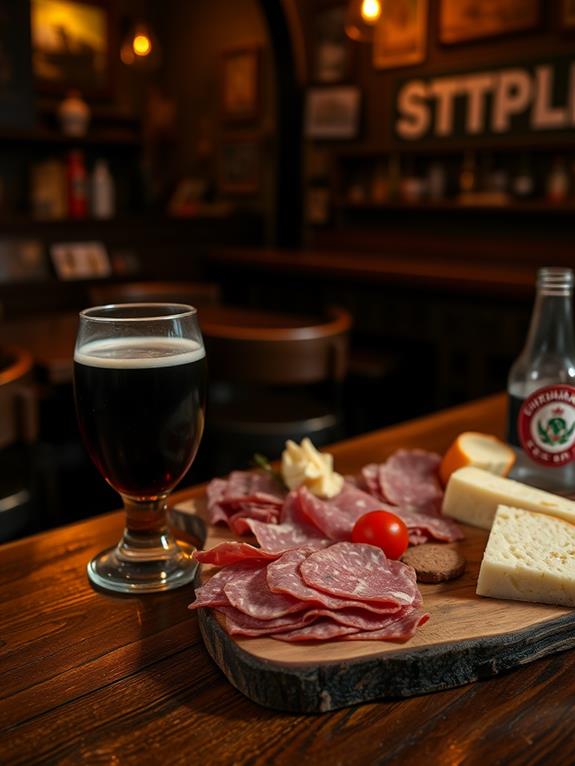
With a solid understanding of the ideal food pairing principles for Scotch Ales, you can now start exploring specific pairing recommendations that will elevate your dining experience.
Scotch Ales, with their rich malt-forward characteristics, pair excellently with game meats like pheasant and quail, enhancing the beer's sweetness and complexity. The robust flavors of roasted meats, such as lamb chops and pork, match perfectly with Scottish Export ales, creating a harmonious balance.
Additionally, some perfect pairings for brown ale can inspire your choices, as both styles share similar flavor profiles. Smoked salmon offers a delightful contrast to the sweetness of Scotch Ales, while also enhancing their smoky undertones, making it an ideal pairing.
For a sweet treat, Strong Scotch Ales complement rich desserts, particularly those featuring dark chocolate or caramel, creating a satisfying balance of flavors.
Scotch Ale Serving Suggestions
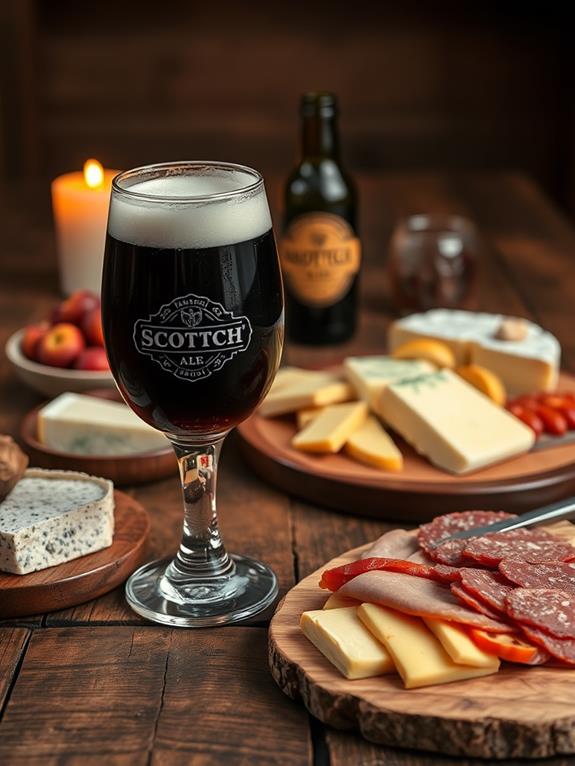
To fully appreciate the complexities of Scotch Ales, it's essential to serve them under the right conditions. This beer style demands attention to detail to reveal its rich malt flavors and aromas, much like the care taken in pairing with Belgian Dubbel.
When it comes to serving temperatures, aim for above 50°F to fully appreciate the beer's intricacies. However, if you're dealing with lighter, sweeter variations, temperatures around 40-45°F can work well.
For the perfect pour, consider the following:
- Use snifters or tulip glasses to enhance the beer's complexities and allow for proper aroma release.
- Make sure your Scotch ale has a large tan head, indicating good carbonation and enhancing the sensory experience.
- Allow the beer to breathe before consumption, as the higher alcohol content can mask its intricate flavors if not handled carefully.
Popular Scotch Ale Varieties
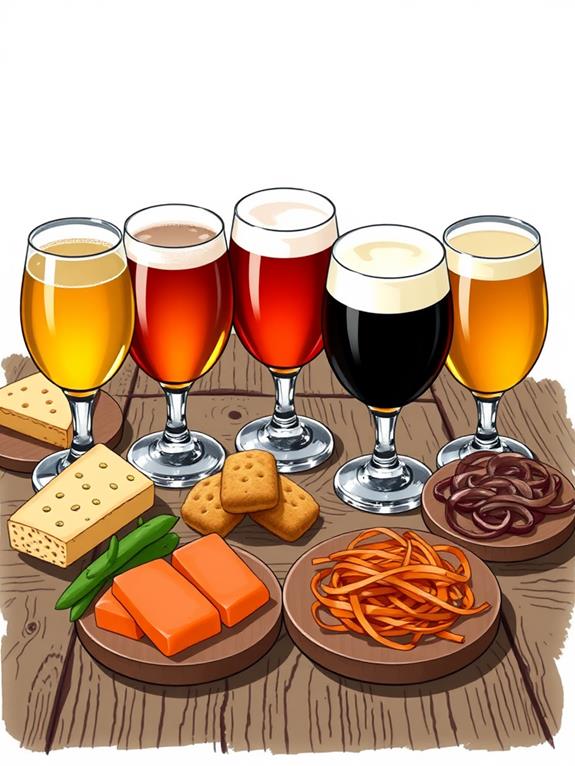
Now that you've mastered the art of serving Scotch Ales, it's time to explore the diverse world of varieties. Scottish Ales come in several styles, each with its unique characteristics, making them ideal for pairing perfection.
You'll find four main types of Scottish Ales. The Scottish Light (60/-) is a lower-alcohol-content ale, light in body, and best enjoyed fresh. The Scottish Heavy (70/-) has a slightly higher alcohol content, offering richer malt flavors. The Scottish Export (80/-) is a stronger variant with more pronounced maltiness and complexity, featuring examples like Orkney Dark Island and Caledonian 80/-.
Strong Scotch Ales, like Traquair House Ale and Belhaven Wee Heavy, are known for their robust flavor and higher alcohol content, reaching up to 10% ABV. Wee Heavy, a dark, malty barleywine, tends to have caramel-forward notes and is traditionally brewed with pale, crystal, and chocolate malts.
When exploring these varieties, consider how they'll pair with your favorite foods and beers.
Enhancing Flavor Profiles
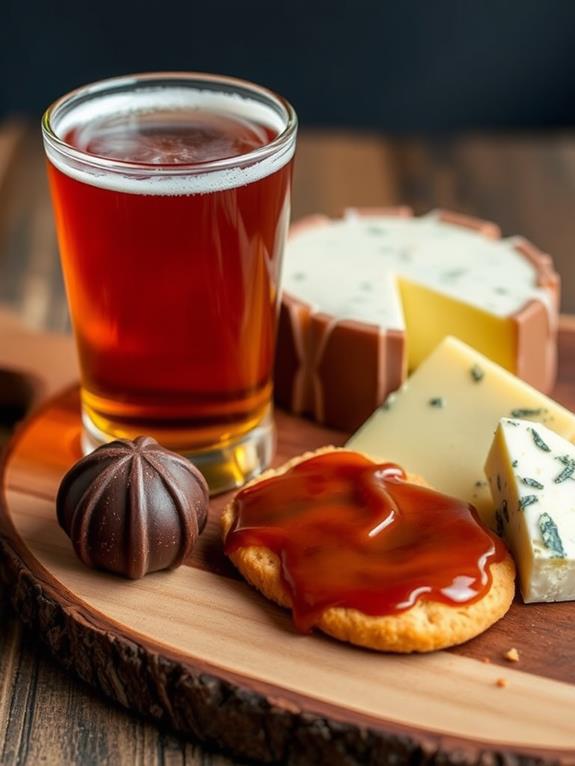
Beyond the domain of ale varieties, the true magic of Scotch Ales lies in their ability to elevate the flavors of dishes they're paired with.
As you explore the world of Scotch Ale food pairings, you'll discover that the rich maltiness and caramel notes of these ales provide a perfect complement to roasted and braised meats, enhancing the overall flavor experience of hearty dishes.
To take your pairings to the next level, consider the following:
- Pairing Scottish ales with smoked meats, such as brisket or smoked salmon, accentuates the beer's depth and complexity, creating a harmonious balance of flavors.
- Incorporating earthy vegetables, like roasted root vegetables, can enhance the beer's flavor profile, as their natural sweetness complements the malt characteristics.
- Rich desserts featuring dark chocolate or caramel, such as brownies or butterscotch pudding, align well with the sweetness of Scotch ales, creating a delightful finish to a meal.
Frequently Asked Questions
What Food Goes Best With Ale?
You're wondering what food goes best with ale? Well, you're in luck! Rich, savory, and sweet flavors all pair amazingly with ale. Whether it's game meats, roasted pork, or decadent dark chocolate treats, ale complements them beautifully, enhancing the experience.
How Do You Drink Scotch Ale?
Savoring scotch ale is an art: you pour it gently, allowing the subtle sweetness to surface, then let it breathe, releasing rich aromas, before sipping it slowly, relishing the complex flavors at the perfect temperature, around 50-55°F.
What Is the Flavor Profile of Scotch Ale?
You experience a rich, malty flavor profile in a Scotch ale, with notes of caramel, toffee, and dark fruit, accompanied by a smooth, warm finish and hints of roasted barley, all balanced by a subtle hop presence.
What Is the Difference Between Scotch and Scottish Ale?
You're wondering what sets Scotch Ale apart from Scottish Ale? It's all about the ABV, friend! Scotch Ale's richer, fuller-bodied flavor profile comes from its higher alcohol content, usually over 7%, whereas Scottish Ale's milder taste has a lower ABV.
